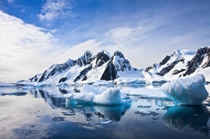Ru
|
Eng
Expert: Lack of an environmental impact is an advantage of using nuclear plants in Arctic conditions
30.03.2017

The international forum The Arctic: Territory of Dialogue is scheduled to take place in Arkhangelsk, Russia on 29-30 March. The forum has been taking place since 2010 and represents a major platform for discussing topical problems and development prospects of the Arctic region together with foreign partners. This year’s forum was focused on people in the Arctic. The forum is designed to bring together international organizations, government agencies, scientific and business circles from Russia and foreign countries for the sake of coordinating approaches to the development of international cooperation, for consolidating efforts to ensure the stable development of the Arctic and for raising living standards in the Arctic territories. President of Russia Vladimir Putin and Deputy Prime Minister Dmitry Rogozin took part in the forum.
Yuri Fadeyev, chief designer for electricity-generating plants with pressurized water-moderated reactors at the engineering company Afrikantov OKBM, said that Rosatom and his company in particular as the agency in charge of designing reactor plants are ready to offer the full range of power-generating facilities that Arctic regions may need, BelTA has learned. A number of projects have been implemented upon orders of the Russian Trade and Industry Ministry recently. Ground-based energy sources are some of them. A submersible modular plant for underwater prospecting and extraction of various kinds of organic raw materials has been developed together by the Advance Research Foundation in association with the marine engineering design company Rubin. The output parameters vary from 5-6MW to 100MW. The smaller power plants are meant for small towns, comparatively small mining enterprises or geological exploration sites. 100MW power plants are designed for large mining and processing factories and mining enterprises.
Apart from that, Afrikantov OKBM has come up with the nuclear reactor Iceberg for underwater and subglacial drilling rigs. The power plant can supply drilling and extraction rigs with electricity, with the output parameters varying from 8MW to 25MW. The power plant can operate without human interference for at least one year. The total working lifespan is designed to be 30 years.
Movement in this direction has just started, projects and designs are few and far between. “We can see that the private sector and the public sector (primarily the Defense Ministry) demonstrate their interest. Feasibility studies are in progress but we understand that it is impossible to successfully explore Arctic regions without such energy sources,” noted Yuri Fadeyev.
The compact location of facilities is a peculiarity of northern regions. Every specific site has its own economic situation. A lot depends on how many power plants will be made and deployed — the larger the number of power plants in one series is, the more economically profitable the series is.
The absence of environmental impact is an advantage of using nuclear power plants in the Arctic in comparison with organic energy resources, which were used there in the past. For instance, empty diesel fuel barrels still need to be extracted from the region.
Russia boasts a unique advantage: the country has the entire infrastructure for using nuclear energy in this area. The marine company Atomflot uses nuclear-powered ships. The company has the entire necessary infrastructure required to operate, repair, and decommission nuclear power plants, including the handling of nuclear fuel.
This is why raising the economic efficiency of using nuclear power plants is the main item on the agenda now. We believe that batch production is the key — the more nuclear power plants we build, the lower the prime cost of each of them is.
It is objectively necessary to develop the Arctic, primarily for Russia. The plans span decades because, according to specialists, 60-70% of the global resources are located over there.
Bearing this point in mind, nuclear power plants offer the optimal working lifespan. At present we design our reactors to last for 60 years. In my opinion, from the technical point of view it will be necessary to extend the lifespan of these reactors afterwards. Let me remind you that the working lifespan of reactors of nuclear-powered icebreakers initially began with 100,000 hours. Now thanks to modern solutions the working lifespan has been extended to 200,000 hours. If we talk about today’s nuclear power plants, we have much more experience and we use cutting-edge materials.
Since the very start Afrikantov OKBM has been developing nuclear power plants for the navy, for icebreakers. We have already developed a large number of components. There are a number of standard solutions. In essence making a 5MW nuclear power plant or a 100MW one makes no difference for us. We can assemble one like a Lego puzzle. The same people and the same manufacturing facilities would be involved in either case.
If we talk about time, a 70-100MW nuclear power plant can be made in 4-5 years (as a floating platform because a ground-based nuclear power plant has its own requirements for licensing the construction site).
ANALYTICS
30.08.2023
21.03.2023
30.08.2021
02.07.2021
23.06.2021
10.06.2021
04.06.2021
03.06.2021
20.05.2021
15.05.2021













